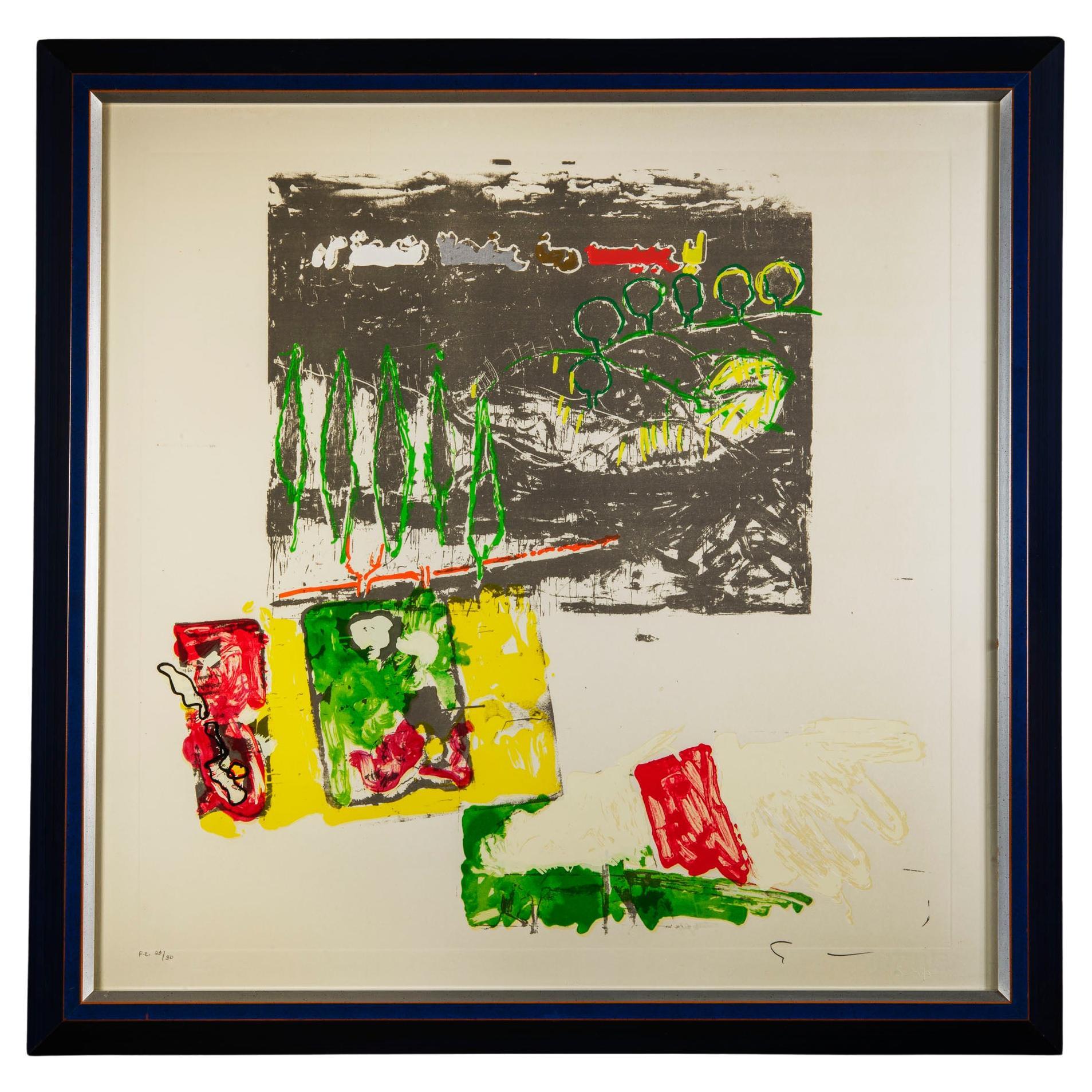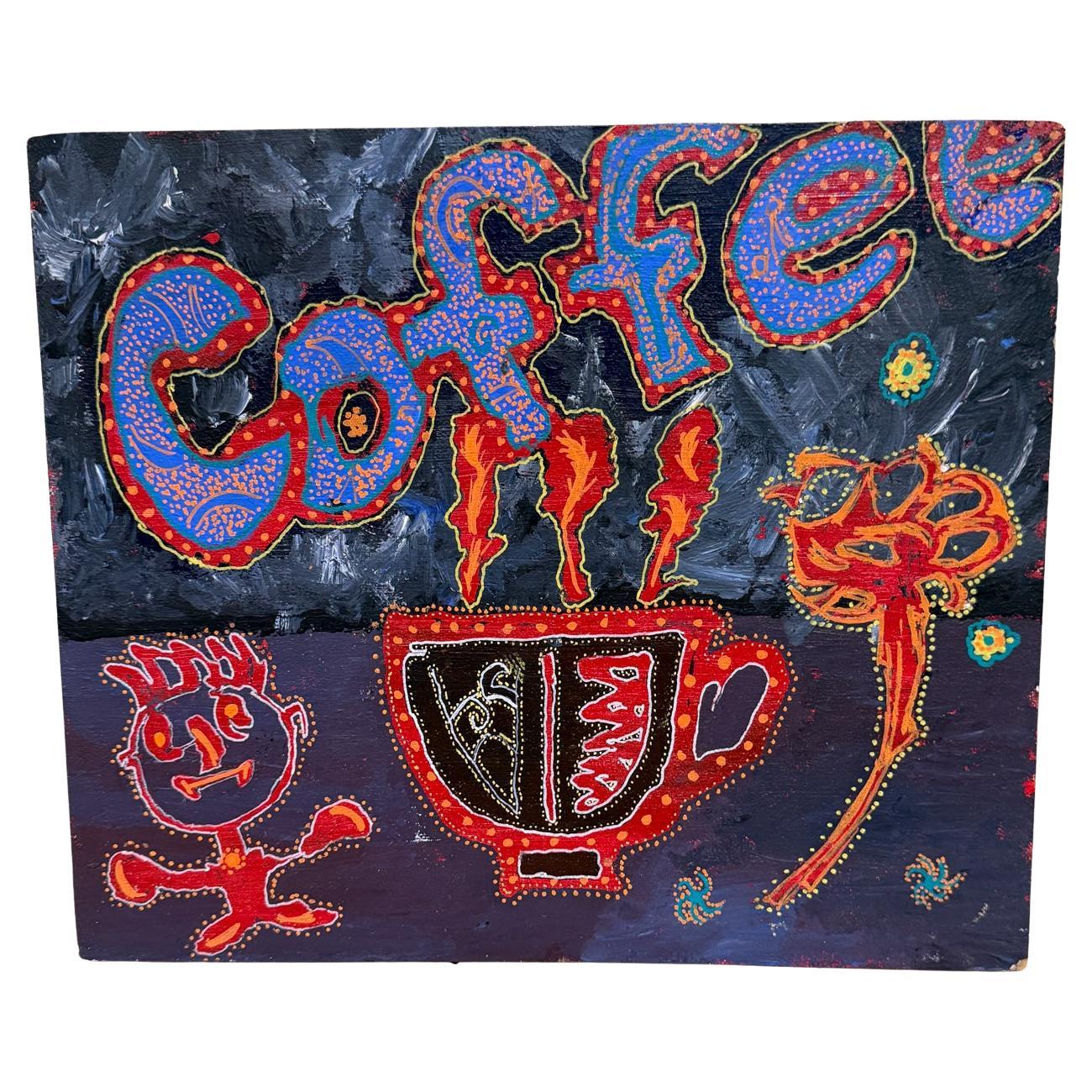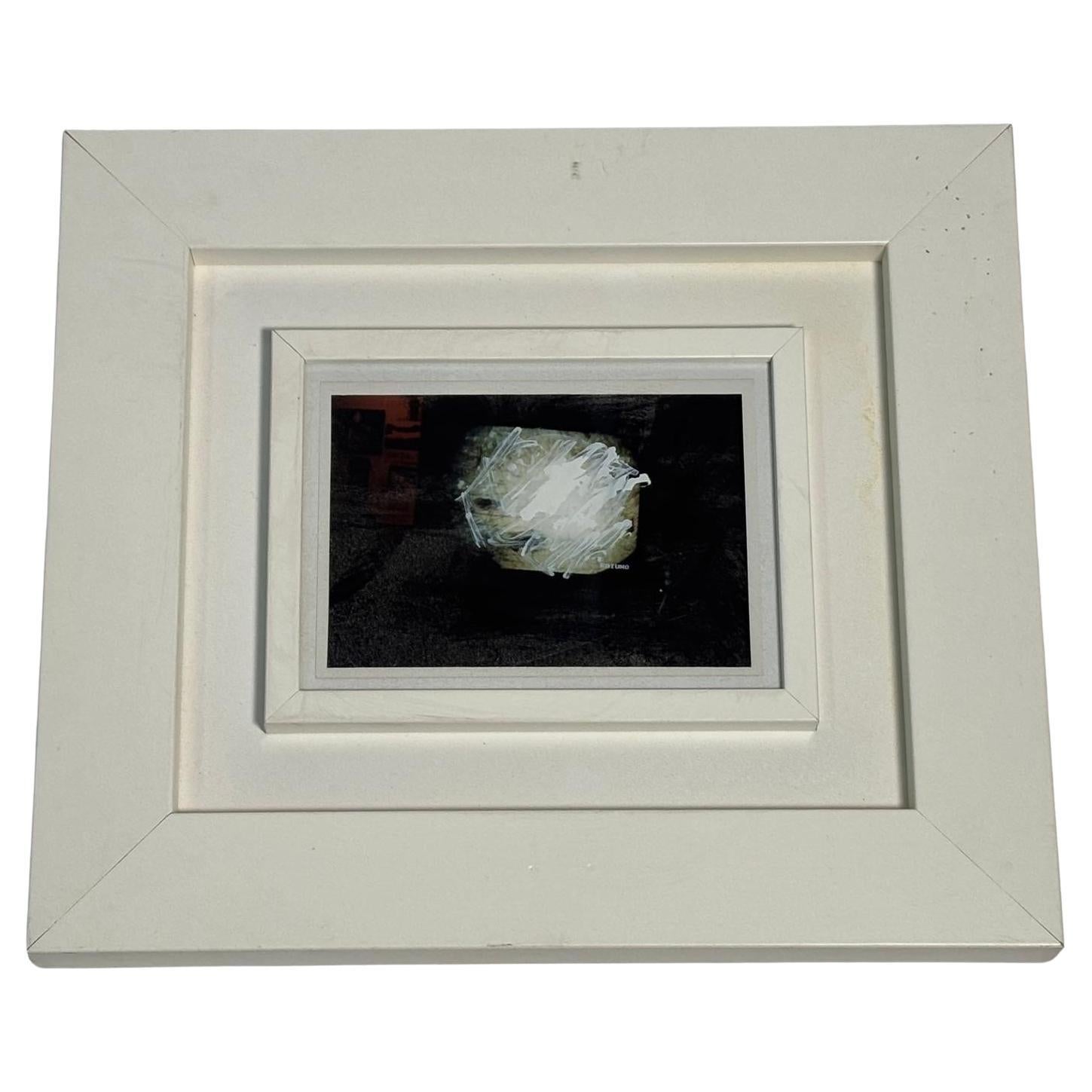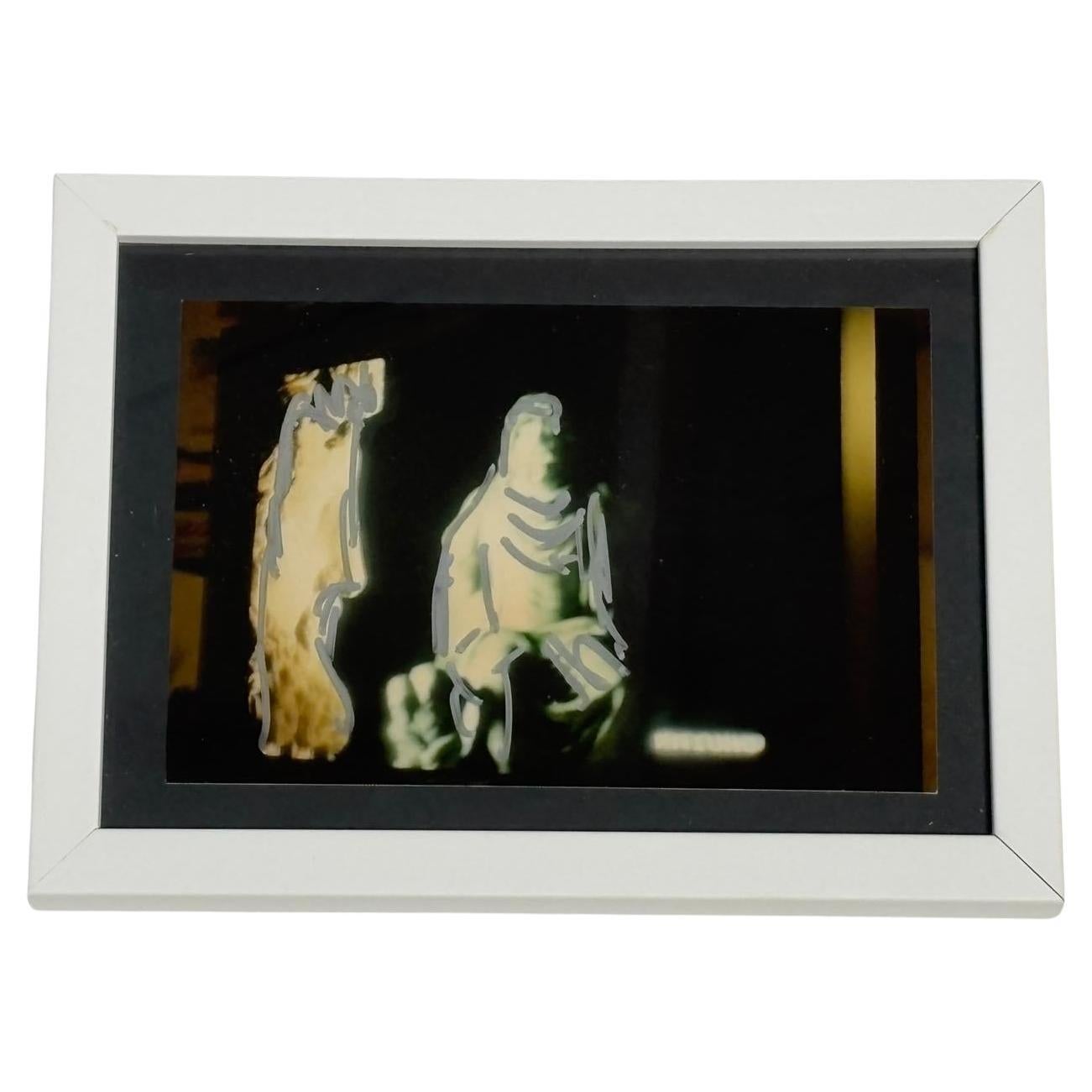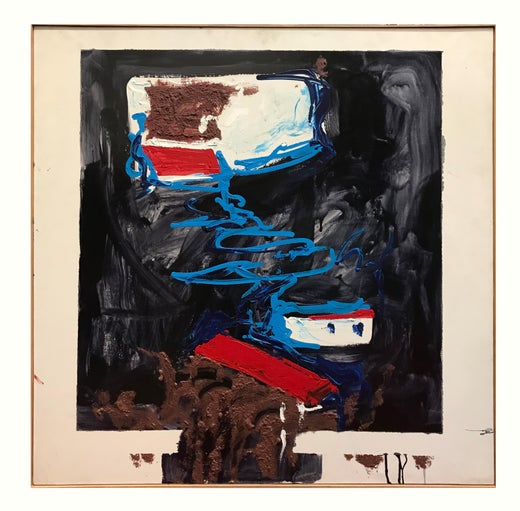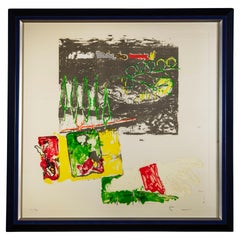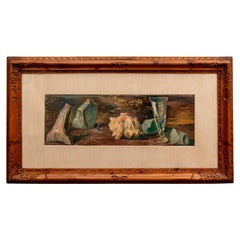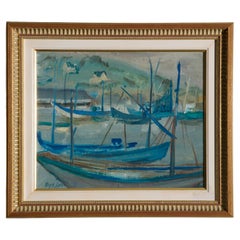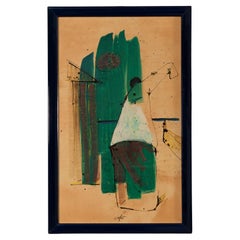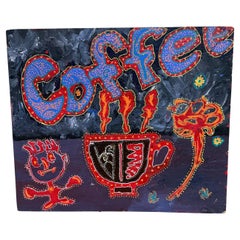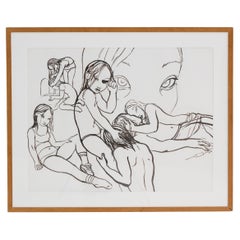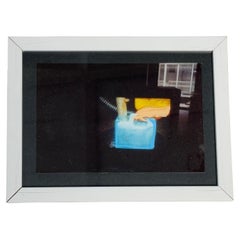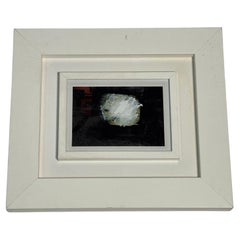Want more images or videos?
Request additional images or videos from the seller
1 of 7
1990s Signed Mario Schifano Artwork
About the Item
Enamel on canvas "Untitled" signature on the back.
Certification by the artist is present.
Archived in 1997 Monte Titano Arte
General Archive of Mario Schifano's paintings n. 713/97 dated 19.09.1997 Monte Titano Arte. Bibliography: the work is present in III° Mario Schifano Works on Canvas 1991-1998 page 401
The dimensions are without frame.
This painting, comes from a private collection and is beautified by an impressive original frame in natural wood, in almost perfect condition.
The painting is also protected by glass
Every item of our Gallery, upon request, is accompanied by a certificate of authenticity issued by Sabrina Egidi official Expert in Italian furniture for the Chamber of Commerce of Rome and for the Rome Civil Courts.
Mario Schifano (Homs 1934 - 1998) was an Italian painter and filmmaker.
Together with Franco Angeli and Tano Festa he represented a fundamental point of Italian and European Pop Art.
Perfectly integrated in the international cultural scene of the 1960s, he was reputed to be a prolific, exuberant and drug-addicted artist.
A keen student of new painting techniques, he was among the first to use computers to create works and was able to process images from the computer and transfer them onto emulsified canvases.
Mario Schifano was born in Italian Libya and after the end of the war returned to Rome where, due to his restless personality, he left school early to follow in his father's footsteps who worked at the Etruscan museum of Villa Giulia as an archaeologist and restorer.
Thanks to this experience, he approached art, initially producing works that were influenced by Informal Art.
His first solo exhibition was at the Galleria Appia Antica in Rome in 1959.
In the late 1950s, he participated in the artistic movement Scuola di Piazza del Popolo together with artists such as Francesco Lo Savio, Mimmo Rotella, Giuseppe Uncini, Giosetta Fioroni, Tano Festa and Franco Angeli.
The group met at Caffè Rosati, a Roman café then frequented by Pier Paolo Pasolini, Alberto Moravia and Federico Fellini, among others, and located in Piazza del Popolo, from which they took their name.
In 1960, the group's works were exhibited in a group show at Galleria La Salita.
In 1961 he exhibited in a solo show at Galleria La Tartarugadi Plinio De Martiis in Rome.
In the meantime, he had met, among others, his future lover Anita Pallenberg at the Caffè Rosati, with whom he made his first trip to New York in 1962, where he came into contact with Andy Warhol and Gerard Malanga at the Factory.
During this period he participated in the New Realists exhibition at the Sidney Janis Gallery, a group show that included most of the young artists of Pop art and Nouveau Réalisme, including Andy Warhol and Roy Lichtenstein.
He then had the opportunity to participate in the New York social scene, which led to his first experiments with LSD.[6]
On his return from New York, after participating in exhibitions in Rome, Paris and Milan, he took part in the XXXII International Art Exhibition in Venice in 1964.
During this period, his paintings defined as 'Anemic Landscapes', in which it is memory that evokes the representation of nature with small details or allusive inscriptions, and the reinterpretations of art history that later led to his famous pictorial works on futurism appear in embryo.
In Rome, he met and frequented Marco Ferreri and Giuseppe Ungaretti to whom, already in his 80s, he offered an evening at Peyote.
But one of the acquaintances of this period that most influenced him was that with Ettore Rosboch, with whom he formed a deep friendship, based on a shared passion for music. In those years, also thanks to their constant trips to London, the two became friends with the Rolling Stones, to whom they introduced Anita Pallenberg, who in 1965 began a relationship with Brian Jones, and years later became Keith Richards' partner.
In 1969, the flat in Piazza in Piscinula in Rome that then belonged to Schifano was used by Ferreri as the set for the film Dillinger is Dead, on the walls of which some of the artist's paintings can be seen.
In 1969, the Rolling Stones dedicated the song Monkey Man to Mario Schifano.
In 1971 some of his paintings were included by Achille Bonito Oliva in the exhibition Vitalità nel negativo nell'arte italiana 1960/70.
Many of his works, the so-called 'monochromes', present only one or two colours, applied on wrapping paper glued on canvas.
The influence of Jasper Johns was manifested in the use of numbers or isolated letters of the alphabet, but in Schifano's way of painting analogies can be traced to the work of Robert Rauschenberg.
In a painting from 1960, one can read the word 'no' painted with drips of colour in large capital letters, as in a wall graffiti.
The influence of Pop art can be seen in all the artistic production of Mario Schifano, who was fascinated by new technologies, advertising, music, photography and experimentation.
In particular, the artist's closest works to Pop Art are those of the 1980s.
Among the most important works of this period are the Propagande, a series dedicated to advertising brands (Coca-Cola and Esso) in which we have a clear example of the conveyance of commonly used and easily recognisable images quoted in multiple ways or details of them, bicycles, flowers and nature in general (among the most famous series are the Paesaggi anemici, Vedute interrotte, L'albero della vita, estinti and Campi di grano).
Among his most recognisable and important works are certainly the emulsion canvases, daughters of those continuous photographic shots that accompanied his entire life, supports on which television images of daily consumption are reproposed, multiple and in a continuous flow with light pictorial interventions.
- Creator:Mario Schifano (Author)
- Dimensions:Height: 11.82 in (30 cm)Width: 7.88 in (20 cm)Depth: 1.97 in (5 cm)
- Style:Mid-Century Modern (Of the Period)
- Materials and Techniques:
- Place of Origin:
- Period:1990-1999
- Date of Manufacture:1997
- Condition:Wear consistent with age and use. Minor fading.
- Seller Location:Roma, IT
- Reference Number:1stDibs: LU4827237426092
Mario Schifano
Mario Schifano (1934-1968) is considered one of the most significant artists of Italian postmodernism. He worked in numerous media throughout his career, but is perhaps best known for his collages consisting of advertising, scrap paper and painted components. During the latter half of his career, Schifano’s work became increasingly political as he explored issues such as the Vietnam War and widespread social unrest through both film and photography. Born in 1934 in Libya, Schifano and his family relocated to Rome after World War II. With little interest in formal schooling, Schifano took up painting independently and began producing mixed-media works, primarily utilizing monochromatic canvases with glued wrapping paper and stenciling applied. These works garnered critical acclaim, and were followed by a number of exhibitions both in Italy and the US. In 1962 he was included in New Realists, an important group show at the Sidney Janis Gallery in New York alongside artists such as Andy Warhol and Roy Lichtenstein. Often employing elements of pop culture, such as brand logos and advertisements, his work is largely considered within the context of Pop art. Although Schifano was consistently productive and critically acclaimed, he struggled with drug addiction for most of his life, a habit that resulted in multiple arrests, which led the artist to label his career maldoto – cursed. He died at the age of 63 in Rome in 1998 (Ref: Sotheby's). His artworks have sold for over 1M€ at Sotheby's.
About the Seller
5.0
Gold Seller
Premium sellers maintaining a 4.3+ rating and 24-hour response times
Established in 2005
1stDibs seller since 2019
87 sales on 1stDibs
Typical response time: 4 hours
- ShippingRetrieving quote...Shipping from: Rome, Italy
- Return Policy
Authenticity Guarantee
In the unlikely event there’s an issue with an item’s authenticity, contact us within 1 year for a full refund. DetailsMoney-Back Guarantee
If your item is not as described, is damaged in transit, or does not arrive, contact us within 7 days for a full refund. Details24-Hour Cancellation
You have a 24-hour grace period in which to reconsider your purchase, with no questions asked.Vetted Professional Sellers
Our world-class sellers must adhere to strict standards for service and quality, maintaining the integrity of our listings.Price-Match Guarantee
If you find that a seller listed the same item for a lower price elsewhere, we’ll match it.Trusted Global Delivery
Our best-in-class carrier network provides specialized shipping options worldwide, including custom delivery.More From This Seller
View All1980s Signed Mario Schifano Artwork on Paper
By Mario Schifano
Located in Roma, IT
Materic silkscreen print “Ondate di gelo” (Frost Waves) by Mario Schifano.
Signature and numbering in pencil on front side.
Dry stamp of the artist on front.
Edition F.C. (Not for sale) 23/30. Framed work.
The artwork for sale is part of the collection 'Best Seller: 31 graphic works by Mario Schifano' edited by Edizioni Torcular Edition on handmade paper with Torcular watermark by Cartiera Magnani of Pescia Printer: Egiziano Piersantini
This artwork, never before on the market, comes from a private collection and is beautified by an impressive original frame in natural wood, in almost perfect condition.
The painting is also protected by glass
Every item of our Gallery, upon request, is accompanied by a certificate of authenticity issued by Sabrina Egidi official Expert in Italian furniture for the Chamber of Commerce of Rome and for the Rome Civil Courts.
Mario Schifano (Homs 1934 - 1998) was an Italian painter and filmmaker.
Together with Franco Angeli and Tano Festa he represented a fundamental point of Italian and European Pop Art.
Perfectly integrated in the international cultural scene of the 1960s, he was reputed to be a prolific, exuberant and drug-addicted artist.
A keen student of new painting techniques, he was among the first to use computers to create works and was able to process images from the computer and transfer them onto emulsified canvases.
Mario Schifano was born in Italian Libya and after the end of the war returned to Rome where, due to his restless personality, he left school early to follow in his father's footsteps who worked at the Etruscan museum of Villa Giulia as an archaeologist and restorer.
Thanks to this experience, he approached art, initially producing works that were influenced by Informal Art.
His first solo exhibition was at the Galleria Appia Antica in Rome in 1959.
In the late 1950s, he participated in the artistic movement Scuola di Piazza del Popolo together with artists such as Francesco Lo Savio, Mimmo Rotella, Giuseppe Uncini, Giosetta Fioroni, Tano Festa and Franco Angeli.
The group met at Caffè Rosati, a Roman café then frequented by Pier Paolo Pasolini, Alberto Moravia and Federico Fellini, among others, and located in Piazza del Popolo, from which they took their name.
In 1960, the group's works were exhibited in a group show at Galleria La Salita.
In 1961 he exhibited in a solo show at Galleria La Tartarugadi Plinio De Martiis in Rome.
In the meantime, he had met, among others, his future lover Anita Pallenberg at the Caffè Rosati, with whom he made his first trip to New York in 1962, where he came into contact with Andy Warhol and Gerard Malanga at the Factory.
During this period he participated in the New Realists exhibition at the Sidney Janis Gallery, a group show that included most of the young artists of Pop art and Nouveau Réalisme, including Andy Warhol and Roy Lichtenstein.
He then had the opportunity to participate in the New York social scene, which led to his first experiments with LSD.[6]
On his return from New York, after participating in exhibitions in Rome, Paris and Milan, he took part in the XXXII International Art Exhibition in Venice in 1964.
During this period, his paintings defined as 'Anemic Landscapes', in which it is memory that evokes the representation of nature with small details or allusive inscriptions, and the reinterpretations of art history that later led to his famous pictorial works on futurism appear in embryo.
In Rome, he met and frequented Marco Ferreri and Giuseppe Ungaretti to whom, already in his 80s, he offered an evening at Peyote.
But one of the acquaintances of this period that most influenced him was that with Ettore Rosboch, with whom he formed a deep friendship, based on a shared passion for music. In those years, also thanks to their constant trips to London, the two became friends with the Rolling Stones, to whom they introduced Anita Pallenberg, who in 1965 began a relationship with Brian Jones, and years later became Keith Richards' partner.
In 1969, the flat in Piazza in Piscinula in Rome that then belonged to Schifano was used by Ferreri as the set for the film Dillinger is Dead, on the walls of which some of the artist's paintings can be seen.
In 1969, the Rolling Stones dedicated the song Monkey Man to Mario Schifano.
In 1971 some of his paintings were included by Achille Bonito Oliva in the exhibition Vitalità nel negativo nell'arte italiana 1960/70.
Many of his works, the so-called 'monochromes', present only one or two colours, applied on wrapping paper glued on canvas.
The influence of Jasper Johns was manifested in the use of numbers or isolated letters of the alphabet, but in Schifano's way of painting analogies can be traced to the work of Robert Rauschenberg.
In a painting from 1960, one can read the word 'no' painted with drips of colour in large capital letters, as in a wall graffiti.
The influence of Pop art can be seen in all the artistic production of Mario Schifano, who was fascinated by new technologies, advertising, music, photography and experimentation.
In particular, the artist's closest works to Pop Art are those of the 1980s.
Among the most important works of this period are the Propagande, a series dedicated to advertising brands (Coca-Cola and Esso) in which we have a clear example of the conveyance of commonly used and easily recognisable images quoted in multiple ways or details of them, bicycles, flowers and nature in general (among the most famous series are the Paesaggi anemici, Vedute interrotte, L'albero della vita...
Category
Vintage 1980s Italian Mid-Century Modern Prints
Materials
Canvas, Glass, Wood
Mario Tozzi Mid-Century Italian Signed and Archived Still Life
By Mario Tozzi
Located in Roma, IT
Mario Tozzi authenticated work
‘Natura morta con figurina smarrita” (Still Life with a Lost Figurine), an unpublished work on the market, signed Mario Tozzi top right.
It represent...
Category
Mid-20th Century Italian Mid-Century Modern Paintings
Materials
Canvas, Wood
Modern French Painting Signed Marine
By Moya Dyring
Located in Roma, IT
Beautiful and evocative oil painting by the great French school modern artist Moya Dyring specializing in marinas.
It depicts a harbor with boats probably from the French Riviera painted with great intensity but giving, at the same time, a sweet sense of serenity.
Moya Claire Dyring was born in Coburg, Victoria in 1909.
She produced drawings, oil paintings and pastels.
She was one of the first women artists to embrace Modernism and exhibit cubist paintings in Melbourne.
For several years she was a member of the modern art community known as the Heide Circle, named after the home of art collectors John and Sunday Reed, and now the Heide Museum of Modern Art.
Every item of our Gallery, upon request, is accompanied by a certificate of authenticity issued by Sabrina Egidi official Expert in Italian furniture for the Chamber of Commerce of Rome and for the Rome Civil Courts.
Dyring then travelled to the USA and France, where she lived most her life. Her work is held in the Heide Museum as well as the National Gallery of Australia.
One of her earliest works in cubist in style, Melanctha, 1934, was acquired by Sunday Reed.
In 1934 Dyring also painted Portrait of Sunday Reed which went into the Reed's collection, along with a cubist style Portrait of a Woman from the same year.
While her early works were figurative or cubist, in France she turned to landscape as she travelled to various towns throughout France.
In her later years, unable to travel freely, she painted children against the backdrop of Paris.
As time passed, she was largely glossed over and not included in major exhibitions of artists, especially women artists, of the 30s, 40, and 50s.
In 2002, at the University of Melbourne, Gaynor Patricia Cuthbert delved into her life and work for a doctoral thesis, helping to bring back attention to her work.
Collection
The Heide Museum of Modern Art holds many paintings and drawings, some acquired through the John and Sydney Reed collection.
The National Gallery of Australia, Canberra includes one drawing.
The Art Gallery of New South Wales holds multiple works.
Third child of Carl Peter Wilhelm Dyring, medical practitioner, and his second wife Dagmar Alexandra Esther, née Cohn, both Victorian born. Moya was educated (1917-27) at Firbank Church of England Girls' Grammar School, Brighton.
After visiting Paris in 1928, she studied (1929-32) at the National Gallery schools, Melbourne, and shared fellow student Sam Atyeo's interest in artistic innovation.
Classical modernism engaged her attention in the early 1930s.
She painted at the George Bell school and studied under Rah Fizelle in Sydney; Mary Alice Evatt and Cynthia Reed were her colleagues.
For several months in 1937 she took charge of Heide, the home and garden of John and Sunday Reed, at Bulleen, Melbourne.
The Reeds were pivotal both to her sympathy for modernism and her belief in congenial fellowship.
She enjoyed something of the intense relationship with Sunday Reed that the latter would subsequently extend to Joy Hester.
In June Dyring held an exhibition, opened by H. V. Evatt, at the Riddell Gallery, Melbourne.
Less enthusiastic than the Reeds and the Evatts about her art, Basil Burdett wrote of her 'somewhat incoherent interpretation of modern ideas', although he did acknowledge that her work had 'audacity of colour and a certain monumental feeling for form . . . qualities rare enough in Australian painting'.
In August Dyring embarked for Panama whence she travelled by bus to New York, breaking her journey to view major galleries.
She had intended to paint in the United States of America, but disliked the work of contemporary American artists and sailed for France.
In 1938 she was based in Paris, taking advantage of Atyeo's contacts within the avant-garde.
She studied at the Académie Colarossi, the Académie de la Grande Chaumière and with Andre Lhote, although by October she denounced him as a 'racketeer'.
In 1939 Dyring and Atyeo settled on a farm at Vence, France; inspired by memories of Heide, they grew fruit and flowers.
Sam accepted a commission to decorate a house in Dominica, West Indies, leaving Moya at Vence.
Evacuated to Australia via South Africa, where she painted and searched for tribal art, she then journeyed to Dominica and married Atyeo.
They were not happy, neither painted and Dyring was ill. Evatt offered Atyeo work and Dyring accompanied him to the U.S.A.
She viewed art, painted occasionally and claimed to have exhibited in Washington in 1943.
After World War II Evatt found Sam various postings, while Moya returned to Paris to pursue a full-time career in art.
They were to be divorced in 1950.
From about 1946 Dyring's art was more personal than innovative.
She gained a considerable reputation among French regionalist and nationalist artists for her sympathetic appreciation of provincial scenes and life.
Bernard Smith placed her in the French tradition of intimiste painters.
In 1948 she leased and renovated an apartment on the Ile St Louis, which, as Chez Moya, became a centre for Australians who enjoyed her hospitality, cooking and practical assistance.
She revisited Australia and exhibited in various cities in 1950, 1953, 1956, 1960 and 1963; the press carried her reports of Parisian cultural life.
Dyring held a solo exhibition in London in December 1949 and was in close contact with expatriate Australians, among them Loudon Sainthill, Donald Friend...
Category
Vintage 1950s French Mid-Century Modern Paintings
Materials
Wood
1960s Italian Signed Abstract Painting
By Nino Caffè
Located in Roma, IT
Nino Caffè, painting on paper, mixed media.
“Vestizione di un pretino” (Vestments of a Young Priest)
Signed bottom center: Caffè.
Young priests in 1950s ...
Category
Vintage 1960s Italian Mid-Century Modern Paintings
Materials
Wood, Paper
Period Italian Signed Landscape Painting
By Demetrio Tabacco
Located in Roma, IT
The great art historian Federico Zeri said that painting snow-covered landscapes was one of the most complicated things for an artist.
Well, in this landscape of the Piedmont country...
Category
Mid-20th Century Italian Mid-Century Modern Paintings
Materials
Canvas, Wood
Contemporary Abstract Oriental Signed Painting
By Kozo Inoue
Located in Roma, IT
Wonderful contemporary abstract Kozo Inoue signed painting
Series of 4 canvas assembled to form a single painting signed Kozo Inoue dated 1974
This painting, never before on the mark...
Category
Mid-20th Century Japanese Mid-Century Modern Paintings
Materials
Canvas
You May Also Like
1990s Artwork Hot Coffee Painting
Located in Chula Vista, CA
AMBIANIC presents
Vintage Painting Coffee Art
Pop Art fun and fabulous
acrylic on board
10.13 x 12 x .3/16
Preowned vintage
Refer to images
Category
Late 20th Century American Modern Paintings
Materials
Paint
Artwork by Rita Ackermann, USA, 1990s
Located in Antwerp, BE
This artwork by Rita Ackermann, rendered in her signature raw, expressive style, captures the essence of youthful turmoil and rebellion. Created in the 1990s, a pivotal period for th...
Category
1990s American Paintings
Materials
Paper
Hand-retouched Photograph by Mario Schifano
By Mario Schifano
Located in Milan, Italy
Without title mixed technique on photograph by Mario Schifano made in 1990-97.
Inscription on the back: signature "Schifano"
With certificate of authenticity. Unique piece.
Biograp...
Category
1990s Italian Modern Photography
Materials
Acrylic
Hand-retouched Photograph by Mario Schifano
By Mario Schifano
Located in Milan, Italy
Without title mixed technique on photograph by Mario Schifano made in 1990-97.
Inscription on the back: signature "Schifano"
With certificate of authenticity. Unique piece.
Biograp...
Category
1990s Italian Modern Photography
Materials
Acrylic
Hand-retouched Photograph by Mario Schifano
By Mario Schifano
Located in Milan, Italy
Without title mixed technique on photograph by Mario Schifano made in 1990-97.
Inscription on the back: signature "Schifano"
With certificate of authenticity.
Biography
In the early...
Category
1990s Italian Modern Photography
Materials
Acrylic
Hand-retouched Photograph by Mario Schifano
By Mario Schifano
Located in Milan, Italy
Without title mixed technique on photograph by Mario Schifano made in 1990-97.
Inscription on the back: signature "Schifano"
With certificate of authenticity. Unique piece.
Biograp...
Category
1990s Italian Modern Photography
Materials
Acrylic
